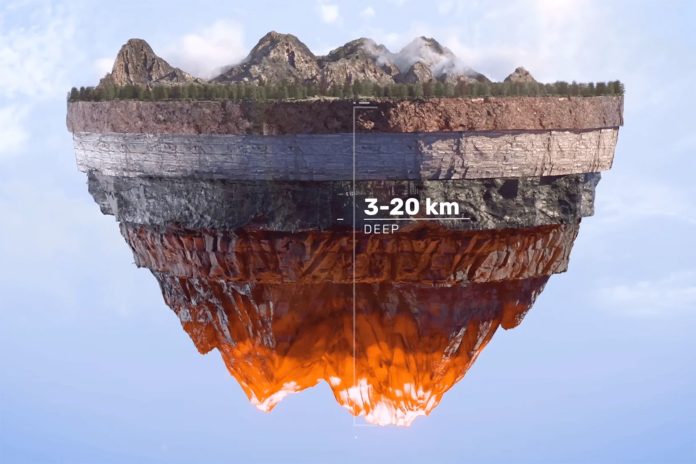Geothermal energy has long been recognized for its potential to provide a steady, renewable source of power. However, its widespread adoption has been limited to regions where underground heat sources are easily accessible. Quaise Energy is working to change that by drilling deeper than ever before to tap into superheated steam, making geothermal power viable in many more locations. In a unique approach, the company is turning to historical technology to help address modern challenges in deep geothermal energy extraction.
Drilling to unprecedented depths
Traditional geothermal power plants rely on naturally occurring underground reservoirs where heat is close to the surface. These conditions exist in select regions, limiting the scalability of geothermal energy. Quaise Energy aims to overcome this limitation by drilling much deeper—up to 12.4 miles (20 km) into the Earth’s crust. At these depths, temperatures reach an estimated 500°C (932°F), creating an entirely new opportunity for harnessing geothermal energy.
To achieve this, Quaise employs a combination of conventional rotary drilling and a gyrotron-powered energy beam, a technique originally developed for nuclear fusion research. This method enables the company to penetrate deep rock formations that traditional drilling methods struggle to reach efficiently.
The power of supercritical water
One of the major benefits of drilling to such depths is the ability to access supercritical water, which exists at temperatures above 373.9°C (705.2°F) and pressures over 218 atmospheres. This state is neither a gas nor a liquid but behaves as a single homogeneous fluid. Supercritical water has unique properties that make it highly efficient for energy generation.
Compared to standard geothermal steam, supercritical water offers:
- Improved flow dynamics: It moves through turbines and heat exchangers more effectively than conventional steam.
- Higher thermal efficiency: It can hold 10 times more energy than liquid water or steam, making it an excellent medium for energy transfer.
- Enhanced heat transfer: Its thermal conductivity falls between that of liquid water and dry steam, improving overall system efficiency.
- Self-cleaning properties: It can dissolve salts and other impurities, reducing scaling and maintenance issues in pipelines.
The challenges of ultra-deep geothermal
While the advantages of supercritical water are clear, bringing it to the surface poses significant challenges. Existing geothermal systems operate at much lower temperatures—typically between 100°C and 250°C (212°F to 482°F)—making them unsuitable for handling such extreme conditions. Additionally, extracting supercritical water from ultra-deep wells leads to issues with mass flow rate and efficiency losses due to phase changes.
Even if the water cools to around 350°C (662°F) by the time it reaches the surface, it can still offer a significantly higher efficiency than conventional geothermal plants. However, ensuring that this process remains stable and efficient requires rethinking existing geothermal power plant designs.
Looking to the past for solutions
To address these challenges, Quaise Energy is revisiting a technique first used in 1914 at the Larderello 1 geothermal plant in Italy. Rather than using a single-loop system—where water is pumped underground and returns as steam—Larderello 1 employed a two-loop heat exchanger system. One loop collected heat deep underground, while a second loop transferred that heat to turbines at the surface.
This method helped protect the generating equipment from highly corrosive underground water, a problem that modern geothermal plants still face. While current systems use organic chemicals like benzene, pentane, butane, and isopentane for heat transfer, Quaise’s approach eliminates the need for these substances. Instead, it relies on water alone, reducing environmental concerns associated with chemical use.
By adopting and refining this century-old heat exchanger system, Quaise aims to make ultra-deep geothermal power both practical and cost-effective.
Potential applications and industry interest
The ability to generate geothermal power from nearly anywhere on Earth could significantly expand the use of renewable energy. Deep geothermal could provide consistent, base-load power to electrical grids, complementing intermittent sources like solar and wind. Additionally, it could be used for industrial heating, regional heating networks, and even home-based ground-source heat pumps.
As Daniel W. Dichter of Quaise Energy explains, “The applications are diverse, from power plants to regional heating to domestic ground-source heat pumps, and there are a lot of fresh new eyes on the field. There’s a renaissance happening in geothermal right now.”
With ongoing advancements in drilling technology and heat transfer systems, Quaise Energy’s approach could represent a major step toward making deep geothermal energy a widely accessible power source. By combining modern innovations with proven historical techniques, the company is working to unlock geothermal energy’s full potential for the future.
Source: Quaise Energy



